May 2022
Preventing Foot Pain When Running
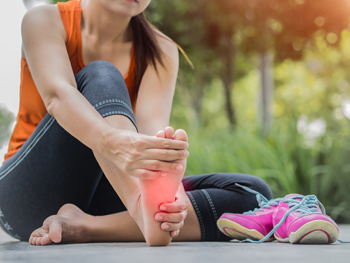
If you enjoy running, keeping your feet healthy will ensure that you can keep running and do so pain-free. Maintaining the strength of all the muscles in the foot is important in preventing pain while running. Do some simple exercises regularly to help build strong feet, which in turn will keep the foot and ankle in better alignment and reduce the risk of injury leading to foot pain. Wear comfortable shoes that fit well and that have proper support. Running shoes should be replaced regularly. Rotate running shoes so that the same areas of the feet, ankles, and legs are not repeatedly stressed. Do not try to do too much, too fast. Listen to your body and slowly build up speed and distance. Have rest days. Practicing good foot health will not guarantee freedom from running injuries but may help prevent them and make healing easier. If you feel pain while running, it is important to visit a podiatrist and get an expert’s diagnosis of the discomfort and advice on how to properly treat the problem.
Ankle and foot injuries are common among athletes and in many sports. They can be caused by several problems and may be potentially serious. If you are feeling pain or think you were injured in a sporting event or when exercising, consult with Milos Tomich, DPM from Dr. Tomich Foot & Ankle Health Center. Our doctor will assess your condition and provide you with quality foot and ankle treatment.
Common Injuries
The most common injuries that occur in sporting activities include:
- Achilles Tendonitis
- Achilles Tendon Rupture
- Ankle Sprains
- Broken Foot
- Plantar Fasciitis
- Stress Fractures
- Turf Toe
Symptoms
Symptoms vary depending upon the injury and in some cases, there may be no symptoms at all. However, in most cases, some form of symptom is experienced. Pain, aching, burning, bruising, tenderness, tightness or stiffness, sensation loss, difficulty moving, and swelling are the most common symptoms.
Treatment
Just as symptoms vary depending upon the injury, so do treatment options. A common treatment method is known as the RICE method. This method involves rest, applying ice, compression and elevating the afflicted foot or ankle. If the injury appears to be more serious, surgery might be required, such as arthroscopic or reconstructive surgery. Lastly, rehabilitation or therapy might be needed to gain full functionality in the afflicted area. Any discomfort experienced by an athlete must be evaluated by a licensed, reputable medical professional.
If you have any questions, please feel free to contact one of our offices located in Milwaukee and Wauwatosa, WI . We offer the newest diagnostic and treatment technologies for all your foot care needs.
It's Time for Beautiful Feet
Finding the Best Running Shoe for Your Feet
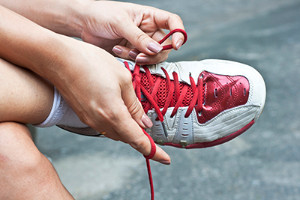
It’s not about the looks or the status, it’s about the fit. When in doubt, experts recommend that when shopping for running shoes to put fit over fashion, brand, or price. Shoes that are too tight can cause blisters, while shoes that are too wide can hurt your toes. Shoes that fit poorly can cause tendonitis, pinched nerves, heel pain, ankle sprains, and stress fractures. Signs that your shoes don’t fit properly include heel slippage, numbness on the top of the feet, and bruising on the toes. The best way to prevent these from occurring is to measure your feet while also wearing the socks you will use as you run. Check your foot measurements periodically, as foot size can change if you gain or lose weight. A rule of thumb is to have at least a half-inch of room between your toes and the end of the shoe. Running shoes usually run about half a size larger than street shoes, to allow for the feet to expand as you run. Try on several types of shoes before making a decision. If you need guidance on the best running shoe for you, please consult a podiatrist.
You should always make sure your running shoes fit properly in order to avoid injury. For more information, contact Milos Tomich, DPM from Dr. Tomich Foot & Ankle Health Center. Our doctor can provide the care you need to keep you pain-free and on your feet.
Choosing the Right Running Shoe for Your Foot Type
Improper shoe sizing can cause a myriad of problems for your feet. Shoes that don’t fit you properly can lead to muscular imbalances in your body, which can result in foot, knee, and hip injuries.
Tips for Finding the Right Running Shoe
- Make sure you have a thumb’s width of wiggle room between the end of your longest toe and the front of the shoe.
- There should be little to no slipping at the heel
- Don’t assume your size in one shoe brand will be your size in another
- Do not lace up your shoes too tightly
- Walk around in the store with your new shoes before you buy them
If you have any questions please feel free to contact our one of our offices located in Milwaukee and Wauwatosa, WI . We offer the newest diagnostic and treatment technologies for all your foot and ankle needs.
The Importance of Dorsiflexion
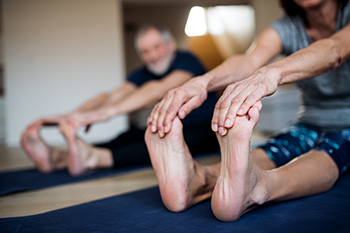
Flexing the foot is not something most people spend a lot of time thinking about until they can’t flex their foot. The process of raising the foot in the direction of the shin, known as dorsiflexion, comes naturally as you learn to walk. It happens as you push off the ground whenever you take a step. Dorsiflexion is the result of using the muscles and tendons in the front of the leg and depends on the deep peroneal nerve. If this nerve is damaged, you may be unable to flex your foot. Other possible causes of poor dorsiflexion include a tightened ankle joint, tight calf muscles, or an ankle injury that has not properly healed. Further, injuries to other parts of the body such as the knee, hip, or back, can affect dorsiflexion. Conversely, any problem with dorsiflexion can cause problems moving upward through the body, all the way to the shoulders. Exercises to stretch the calf muscles and strengthen the ankle joint are ways to improve dorsiflexion. If you are unable to flex your foot fully, or at all, please see a podiatrist for an examination, diagnosis, and treatment options.
If you have any concerns about your feet, contact Milos Tomich, DPM from Dr. Tomich Foot & Ankle Health Center. Our doctor can provide the care you need to keep you pain-free and on your feet.
Biomechanics in Podiatry
Podiatric biomechanics is a particular sector of specialty podiatry with licensed practitioners who are trained to diagnose and treat conditions affecting the foot, ankle and lower leg. Biomechanics deals with the forces that act against the body, causing an interference with the biological structures. It focuses on the movement of the ankle, the foot and the forces that interact with them.
A History of Biomechanics
- Biomechanics dates back to the BC era in Egypt where evidence of professional foot care has been recorded.
- In 1974, biomechanics gained a higher profile from the studies of Merton Root, who claimed that by changing or controlling the forces between the ankle and the foot, corrections or conditions could be implemented to gain strength and coordination in the area.
Modern technological improvements are based on past theories and therapeutic processes that provide a better understanding of podiatric concepts for biomechanics. Computers can provide accurate information about the forces and patterns of the feet and lower legs.
Understanding biomechanics of the feet can help improve and eliminate pain, stopping further stress to the foot.
If you have any questions please feel free to contact one of our offices located in Milwaukee and Wauwatosa, WI . We offer the newest diagnostic and treatment technologies for all your foot and ankle needs.
Causes of Plantar Fasciitis
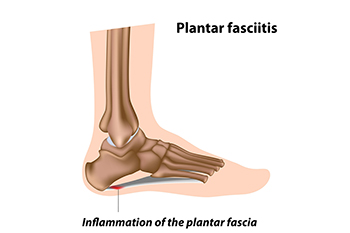
Plantar fasciitis is inflammation of the plantar fascia, the band of fibrous tissue that runs the length of the bottom of the foot to the heel bone. This condition typically develops from over-stretching of that area, and can result in heel and arch pain and heel spurs. Excessive stretching of the plantar fascia can happen for numerous reasons, including flat feet, a sudden increase in physical activity, high body weight and its pressure on the foot, and footwear that is ill fitting. Pain with plantar fasciitis is often its worst first thing after arising from sleep and can diminish a bit as the day wears on. Treatments might be orthotics to reduce over-pronation, cushioning the heel to absorb shock, wearing supportive shoes that accommodate the foot well, losing weight, stretching exercises, and night splints. Since it is vital to determine the cause of plantar fasciitis to treat it properly, it is suggested that a podiatrist be consulted for evaluation.
Plantar fasciitis is a common foot condition that is often caused by a strain injury. If you are experiencing heel pain or symptoms of plantar fasciitis, contact Milos Tomich, DPM from Dr. Tomich Foot & Ankle Health Center. Our doctor can provide the care you need to keep you pain-free and on your feet.
What Is Plantar Fasciitis?
Plantar fasciitis is one of the most common causes of heel pain. The plantar fascia is a ligament that connects your heel to the front of your foot. When this ligament becomes inflamed, plantar fasciitis is the result. If you have plantar fasciitis you will have a stabbing pain that usually occurs with your first steps in the morning. As the day progresses and you walk around more, this pain will start to disappear, but it will return after long periods of standing or sitting.
What Causes Plantar Fasciitis?
- Excessive running
- Having high arches in your feet
- Other foot issues such as flat feet
- Pregnancy (due to the sudden weight gain)
- Being on your feet very often
There are some risk factors that may make you more likely to develop plantar fasciitis compared to others. The condition most commonly affects adults between the ages of 40 and 60. It also tends to affect people who are obese because the extra pounds result in extra stress being placed on the plantar fascia.
Prevention
- Take good care of your feet – Wear shoes that have good arch support and heel cushioning.
- Maintain a healthy weight
- If you are a runner, alternate running with other sports that won’t cause heel pain
There are a variety of treatment options available for plantar fasciitis along with the pain that accompanies it. Additionally, physical therapy is a very important component in the treatment process. It is important that you meet with your podiatrist to determine which treatment option is best for you.
If you have any questions, please feel free to contact one of our offices located in Milwaukee and Wauwatosa, WI . We offer the newest diagnostic and treatment technologies for all your foot care needs.
Grading the Severity of a Sprained Ankle
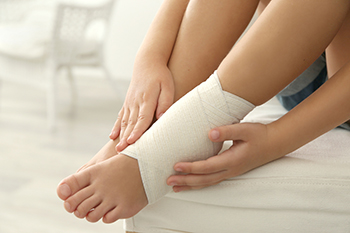
Ankle sprains are injuries that affect many people, regardless of how active or inactive they may be. Ankle sprains occur when one or more of the strong ligaments that support and bind the ankle become stretched beyond their normal bounds, or even torn in severe cases. This injury causes varying degrees of pain, swelling, and mobility issues which are graded by severity. Grade 1 ankle sprains cause mild pain and swelling, and there is no visible bruising, joint instability, or difficulty bearing weight. Ligaments are minimally stretched, so recovery time generally falls within one to three weeks. With a grade 2 ankle sprain the pain, swelling, and tenderness can range from mild to moderate. There may be some joint instability and bruising. Bearing weight may be painful, and it may be difficult to move the ankle. The recovery time typically doubles, because the ligament has been partially torn. A grade 3 ankle sprain is the most severe because the ligament(s) have torn fully or ruptured. This causes severe pain, swelling, bruising, and tenderness. It is impossible to walk due to the ankle being considerably unstable and unable to bear weight. Also, a grade 3 ankle sprain can take several months to fully heal. If you believe you have sprained your ankle, make an appointment with a podiatrist as soon as possible.
Ankle sprains are common but need immediate attention. If you need your feet checked, contact Milos Tomich, DPM from Dr. Tomich Foot & Ankle Health Center. Our doctor can provide the care you need to keep you pain-free and on your feet.
How Does an Ankle Sprain Occur?
Ankle sprains take place when the ligaments in your ankle are torn or stretched beyond their limits. There are multiple ways that the ankle can become injured, including twisting or rolling over onto your ankle, putting undue stress on it, or causing trauma to the ankle itself.
What Are the Symptoms?
- Mild to moderate bruising
- Limited mobility
- Swelling
- Discoloration of the skin (depending on severity)
Preventing a Sprain
- Wearing appropriate shoes for the occasion
- Stretching before exercises and sports
- Knowing your limits
Treatment of a Sprain
Treatment of a sprain depends on the severity. Many times, people are told to rest and remain off their feet completely, while others are given an air cast. If the sprain is very severe, surgery may be required.
If you have suffered an ankle sprain previously, you may want to consider additional support such as a brace and regular exercises to strengthen the ankle.
If you have any questions please feel free to contact one of our offices located in Milwaukee and Wauwatosa, WI . We offer the newest diagnostic and treatment technologies for all your foot and ankle needs.





